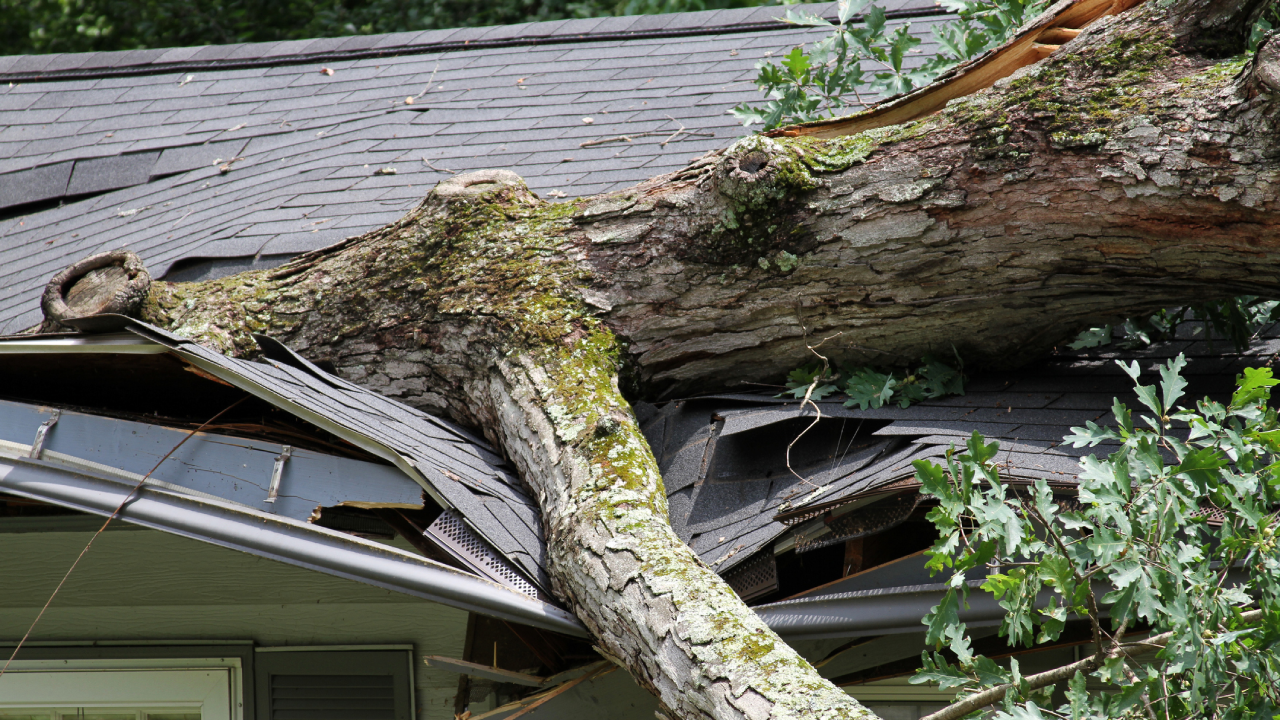Key takeaways
- The frequency of natural disasters is increasing, and the cost to rebuild a home is at record highs.
- It’s essential to maintain accurate records and document any impacts from extreme weather to support your insurance claim.
- Homeowners may have other recover options, such as FEMA disaster assistance, but they are likely to be a fraction of what an insurance claim would provide.
As construction costs reach record highs and climate change fuels more frequent and deadlier storms, home insurance plays an increasingly vital role in protecting homeowners’ finances during an era of rising risk.
Last year, the federal government declared 90 major climate-driven disasters, nearly double the 30-year annual average, according to an analysis by the International Institute for Environment and Development (IIED) of data from the Federal Emergency Management Agency (FEMA). July and August are the months that have the most natural disasters, according to IIED.
As of early July, the U.S. government has declared 31 natural disasters in 2025 so far, including the July 4 flash floods in central Texas. This disaster has taken the lives of at least 120 people, plus over 150 people in central Texas are still missing. In addition to the tragic loss of lives, the flooding caused $18-$22 billion in damages and losses, according to an Accuweather estimate.
Having a home insurance policy won’t stop extreme weather, but it can offer crucial financial protection when disaster strikes. Yet as insurers raise rates to cover their growing climate-related losses, homeowners are struggling to keep up with rising premiums, says Andrew Hoffman, a professor at the University of Michigan’s Ross School of Business and School for Environment and Sustainability.
Increased storm frequency and severity is the new normal of a climate-changed world — this is the conclusion of the nation’s scientists, but more directly, it is the conclusion of the nation’s insurers.
— Professor Andrew Hoffman, Ross School of Business and School for Environment and Sustainability, University of Michigan
The cost of home insurance premiums “is increasing rapidly around the country in response to extreme weather payouts,” Hoffman adds.
The average annual premium for $300,000 of dwelling coverage was $2,329 in May, an increase of 8.4 percent from a year earlier, according to Bankrate calculations using data from Quadrant Information Services. That’s more than triple the 2.4 percent gain during the same period in the government’s Consumer Price Index, which measures overall inflation.
Financial impact of natural disasters
The financial ramifications of natural disasters are profound and far-reaching. For most Americans, their home is the largest financial investment they will ever make. And, the cost of repairing or replacing it after a disaster is the highest it’s ever been, according to the National Association of Home Builders. Average construction costs are now at a record $162 per square foot, the trade group said in a report earlier this year. Without sufficient insurance, homeowners could face steep out-of-pocket costs.
The Bankrate Extreme Weather survey illustrates how impactful natural disasters can be on individuals and communities:
- 26% of homeowners said they are unprepared for the potential costs associated with a natural disaster.
- 43% of homeowners said they haven’t done anything to protect their property from damage stemming from extreme weather.
- 15% of homeowners said they wouldn’t have the financial resources to cover their insurance deductible if their home is damaged by extreme weather.
- 9% of homeowners said they moved to an area at lower risk of extreme weather within the past five years.
Home insurance vs. federal disaster assistance
Faced with rising premiums and, in some disaster-prone areas, few insurers willing to write policies because of increasing risk, one in 13 homeowners is going without property insurance, according to the Consumer Federation of America.
Homeowners who want to “go bare” — the industry’s term for forgoing insurance — will likely be disqualified for mortgage eligibility. Lenders typically require home insurance to protect their collateral. For most people, whether they have a mortgage or not, having their home destroyed or heavily damaged without insurance coverage would threaten their financial stability.
“For most American homeowners, their house is not only their home but also their largest financial asset,” reports the Consumer Federation of America. “Without insurance, they are at risk of losing everything in just one disaster. ”
Some people believe that if their homes were destroyed, the federal government would step in to help them rebuild. There are two problems with that.
First, financial grants from the Federal Emergency Management Agency (FEMA) typically are a fraction of what a home insurance policy will cover. For example, the average payout for FEMA’s Housing Assistance program for temporary shelter and home repairs was $4,253 in the August 2017 to March 2024 period, according to a Congressional Research Service report last year. Meanwhile, the average cost to repair fire damage is $27,175 and storm damage is $12,346.
Another problem is that it’s not clear whether FEMA will be around in coming years. President Donald Trump said last month that he plans to eliminate FEMA after the November 30 end of hurricane season.
“We want to wean off of FEMA, and we want to bring it back to the state level,” the president said.
The National Oceanic and Atmospheric Administration (NOAA) predicts that the 2025 hurricane season, which began on June 1, will have six to 10 hurricanes, with three to five being major hurricanes, meaning wind speeds of 111 miles per hour or higher.
“This outlook is a call to action: be prepared,” says NOAA’s National Weather Service Director Ken Graham. “Take proactive steps now to make a plan.”
Insurance can be customized to address your home’s risks
A standard home insurance policy may not provide adequate coverage, depending on your circumstances and where you live. Thankfully, home insurance is rather customizable. Bankrate’s Extreme Weather survey reports that 29 percent of homeowners made a change to their insurance policy within the last five years to protect their property against damage from extreme weather. You may want to consider purchasing additional coverage or policy add-ons, known as endorsements, that can provide financial protection for a variety of disasters.
- Flood insurance: Flood insurance isn’t included in a standard home insurance policy. The average flood insurance claim is $68,000, so having flood insurance, even if you’re not in a federally designated flood zone, could pay off after a natural disaster. According to FEMA, only about 4 percent of homeowners have flood insurance and 40 percent of claims come from insured homes outside of flood zones.
- Wildfire coverage: Some home insurance policies include coverage for wildfires, but others require you to purchase additional coverage
- Earthquake coverage: If you live in an earthquake zone, you may want to purchase this endorsement, since it’s typically excluded from home insurance policies.
- Windstorm coverage: Most wind damage is covered by standard home insurance policies. However, in some parts of the country, you’re more likely to have to purchase a windstorm endorsement.
Filing an insurance claim after a natural disaster
If you experience a loss that is covered by your home insurance policy, you can file a claim, and you’ll be reimbursed up to your policy limits, minus the deductible cited in your policy. In most cases, insurance will cover home improvements after a disaster — at least in part, assuming you have appropriate coverage.
Home insurance policies can help to pay for property damage caused by extreme weather, and a separate flood insurance policy will cover damage from natural floods. However, after large disasters, claims may take longer to be paid due to heightened demand. If your home repairs and other losses aren’t completely covered by standard home insurance, there are several ways you could get help for disaster relief.
Other ways to get financing for disaster assistance
If you need additional assistance with paying for home repairs or replacement after a disaster, you may want to consider the following options.
- SBA loans: Despite its name —- the U.S. Small Business Administration —- individuals who live in a declared disaster area may qualify for a low-interest disaster SBA loan. However, keep in mind that the loan will be vetted using traditional standards, so it’s essential to maintain your credit score, even in the face of financial disruptions that may arise after a natural disaster.
- FEMA programs: FEMA offers help such as home repair and home replacement grants to individuals with unlivable or damaged homes in a federally declared disaster area. Keep in mind that it is not a replacement for flood insurance, as the payout is likely to be only a fraction of what a flood claim would cover. To apply for help online, go to DisasterAssistance.gov. You can also download the FEMA app to apply and to find other resources such as shelters. Or, call the FEMA Helpline at 1-800-621-3362. It’s staffed between 7 a.m. and 11 a.m. ET every day.
- Personal loan: Personal loans are typically easy to apply for from banks, credit unions or virtual lenders. Often, you can apply for a loan and have the funds available the next day. You just need to show proof of income and employment to verify you can repay the loan.
- Home equity loan: Home equity loans are typically available in larger sums than personal loans since they are secured against the equity you have in your home. It may be difficult to get an equity loan if severe damage has lowered the value of your property.
Bottom line
In a world of escalating natural disasters and record-breaking construction costs, home insurance has evolved from a safety net into a financial lifeline. Relying on government assistance is a risky bet, as benefits typically fall far short of necessary rebuilding costs and the future of adequate assistance is increasingly uncertain. By understanding your insurance options and preparing for emergencies, you can help safeguard your home — the most significant investment many will ever make — against the unpredictable forces of nature.
Why we ask for feedback
Your feedback helps us improve our content and services. It takes less than a minute to
complete.
Your responses are anonymous and will only be used for improving our website.
Help us improve our content
Read the full article here
















